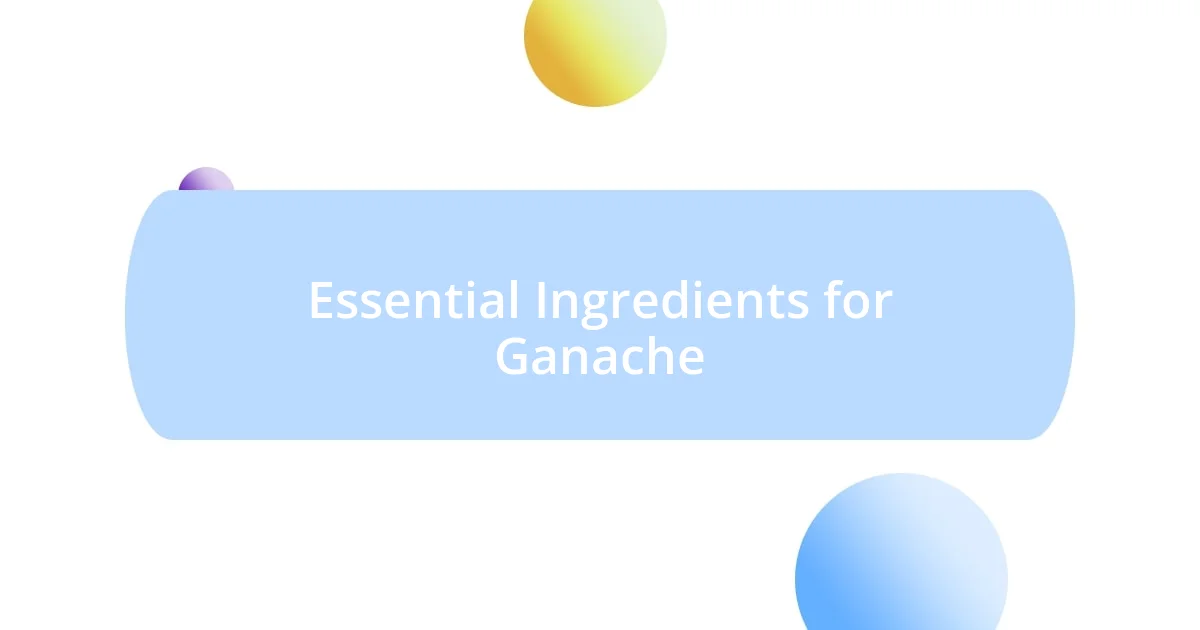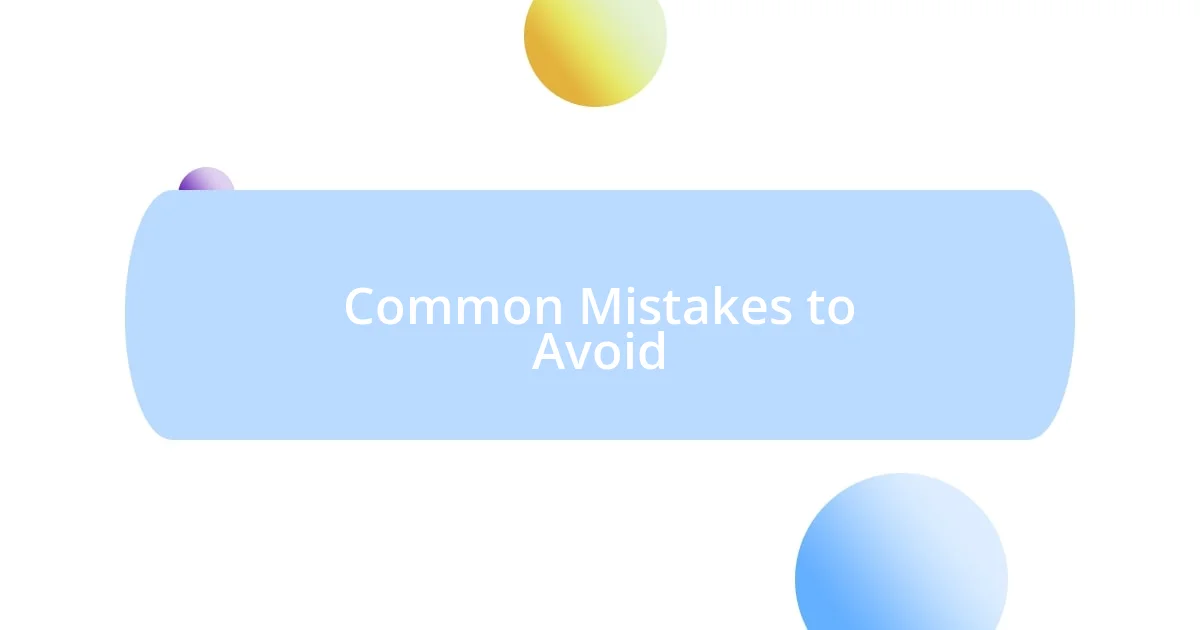Key takeaways:
- Ganache’s texture and purpose depend greatly on the chocolate-to-cream ratio; a 1:1 ratio yields a filling while a 2:1 ratio results in a frosting.
- Mastering temperature and ingredient quality is crucial in making ganache to avoid graininess and achieve a silky finish.
- Exploring flavor variations and creative uses, such as fillings for macarons or glazes for cakes, can elevate ganache beyond a simple topping.

Understanding Ganache Basics
Ganache is a rich and versatile concoction made from chocolate and cream, and mastering it feels like unlocking a secret treasure in the culinary world. I still remember my first attempt; I was nervous as I melted the chocolate, anxiously peering into the bowl, wondering if I would create something magical or a chocolate disaster. Have you ever felt that thrill when trying a new recipe?
It’s fascinating how the proportions of cream to chocolate drastically change the ganache’s texture and purpose. A 1:1 ratio creates a luscious filling for truffles, while a 2:1 ratio makes for a spreadable frosting. Imagine pouring a warm, silky ganache over a cake, watching it cascade down the sides. It’s not just about the flavor; it’s about the whole experience of creating and sharing something beautiful.
I often find that experimenting with different types of chocolate can enhance the experience. Milk chocolate brings sweetness, while dark chocolate adds depth and complexity. There’s an excitement in discovering how a simple tweak can transform an ordinary dessert into something extraordinary. Have you tried using flavored creams or even adding spices? Those small changes can take your ganache to new heights!

Essential Ingredients for Ganache
The heart of ganache lies in its key ingredients: chocolate and cream. I’ve experimented with various types of chocolate over the years, each bringing its own personality to the mix. Dark chocolate, for instance, lends a rich bitterness that beautifully contrasts with the sweetness of heavy cream, while white chocolate offers a creamy, sweet profile that can be quite indulgent. It’s a delightful dance of flavors!
When it comes to cream, I prefer using heavy cream for its ability to create that irresistible silky texture. I remember the first time I used whipping cream instead; the ganache turned out thinner, and I realized how crucial the cream’s fat content is. It’s astonishing how a slight variation in ingredients can dramatically alter the end result.
One of my favorite personal tweaks is adding a pinch of salt or a splash of vanilla extract to the mix. It’s incredible how these simple additions can elevate the ganache, enhancing the chocolate notes while creating a rich, harmonious flavor. Have you tried infusing your cream with other flavors, like mint or espresso? These little experiments have led to some of my most memorable dessert moments.
| Ingredient | Description |
|---|---|
| Chocolate | Forms the base, varying from dark to white, affecting flavor and richness. |
| Heavy Cream | Provides richness and creaminess; fat content is crucial for texture. |

Techniques for Perfect Ganache
When it comes to achieving the perfect ganache, mastering the temperature is crucial. I still recall a late-night chocolate mishap when I poured hot cream over chocolate, only to find it seized up into a grainy texture. It was a disappointing moment, but it taught me the essential lesson of getting the temperature just right—allow the cream to come to a gentle simmer, not a boil, to ensure a smooth blend.
Here are some techniques I’ve found helpful for perfecting ganache:
- Use a candy thermometer: Monitor the cream’s temperature to avoid boiling and achieve that ideal gentle simmer.
- Chop your chocolate finely: This allows it to melt faster and more evenly when combined with the hot cream.
- Gently stir: Once combined, use a whisk or spatula to blend until the ganache is silky smooth, but avoid vigorous mixing that could introduce air bubbles.
- Let it rest: Patience pays off! Allow your ganache to sit for a few minutes after mixing to ensure all the chocolate is fully melted and the texture perfect.
In my experience, the type of vessel you use can also make a difference. I prefer a heavy-bottomed saucepan; it retains heat well and distributes it evenly. There was one holiday when I used a flimsy pan to make ganache for gifts, and it resulted in an uneven texture that had me scrambling for a backup plan. It’s funny how something seemingly small can impact your results significantly, but these little tips and tricks have turned my ganache creations into the smooth indulgences I always envisioned.

Common Mistakes to Avoid
One common mistake I made early on was rushing the cooling process. I remember trying to chill my ganache too quickly in the fridge, which resulted in a grainy texture that was far from the silky smooth finish I was aiming for. Patience really is key here; allowing it to cool naturally at room temperature ensures a much better consistency.
Another pitfall is not adjusting the chocolate-to-cream ratio correctly. I once thought throwing in extra chocolate would yield a richer ganache, but instead, it became too stiff and hard to work with. Finding the right balance is crucial, and sometimes a small tweak can make all the difference. Have you ever gone overboard with an ingredient and regretted it? Trust me, stick to this golden ratio for the best results.
Finally, overlooking the importance of quality ingredients can completely derail your ganache. I vividly recall a time when I grabbed some old chocolate chips from the back of my pantry, thinking they’d work just fine. The result was a ganache that was nowhere near as rich or flavorful as I had hoped. Always choose fresh, high-quality chocolate and cream for that luxurious taste—your taste buds will thank you!

Flavor Variations of Ganache
Exploring flavor variations of ganache has been one of my most delightful journeys in the kitchen. I’ve played around with infusing flavors like lavender or espresso, and each time it’s an exciting experience. For instance, I once added a dash of orange zest to a dark chocolate ganache, and the bright citrus notes elevated the chocolate’s richness beautifully. Have you ever tried pairing unexpected flavors? You might just find a new favorite!
I’ve also ventured into the world of liqueurs, which can add a sophisticated twist to your ganache. A splash of rum or amaretto can not only enhance the overall flavor but also impart a subtle depth. I vividly recall in my early experimentation, I added too much Grand Marnier to a batch, thinking it would balance perfectly. It did become a standout, but let’s just say it was a more spirited dessert than I’d intended! The lesson? Go slow with the spirits and taste as you go to strike that ideal balance.
Then there are fruit purees, which can inject freshness into your ganache. One of my go-to combinations is raspberry puree with white chocolate; the tartness of the berries contrasts so well with the creaminess. I’ll never forget the joy on my friends’ faces when I served it at a dinner party—a reminder of how powerful simple flavor variations can be. Have you experimented with fruits in your ganache? It’s a surprisingly refreshing twist that has the potential to impress!

Creative Uses for Ganache
Thinking outside the box with ganache has led me to some delightful surprises. One time, I decided to use ganache as a filling for macarons. The rich, creamy texture paired perfectly with the delicate shells. My friends were amazed by the velvety contrast, and it quickly became a requested treat at gatherings. Have you ever thought of ganache as anything other than a topping?
Another creative outlet I’ve explored is using ganache as a glaze for cakes. The visual appeal of a glossy ganache finish is something I thoroughly enjoy. One unforgettable moment was when I covered a simple vanilla cake with dark chocolate ganache—everyone marveled at how something so easy could look so elegant. I remember how it turned out shimmering under the candlelight, truly elevating the whole dessert experience. Isn’t it incredible how a simple technique can transform a cake’s allure?
Finally, ganache isn’t just for desserts; I’ve also incorporated it into savory dishes. The first time I paired a mild chocolate ganache drizzled over a spicy chili dish, I was pleasantly surprised by the depth it added. It created a harmony between flavors that I didn’t think was possible. Have you ever considered experimenting with sweet and savory combinations? Trust me; ganache can create that perfect balance if you give it a chance!














